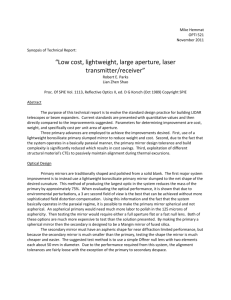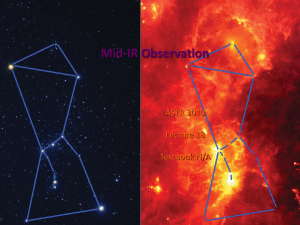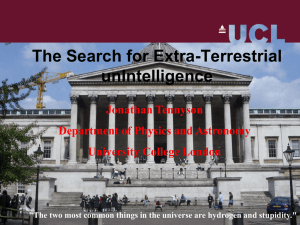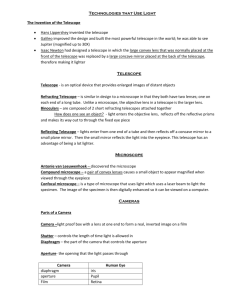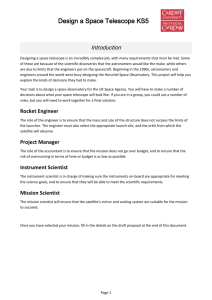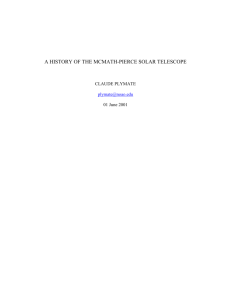Design a Space Telescope - Herschel Space Observatory
advertisement
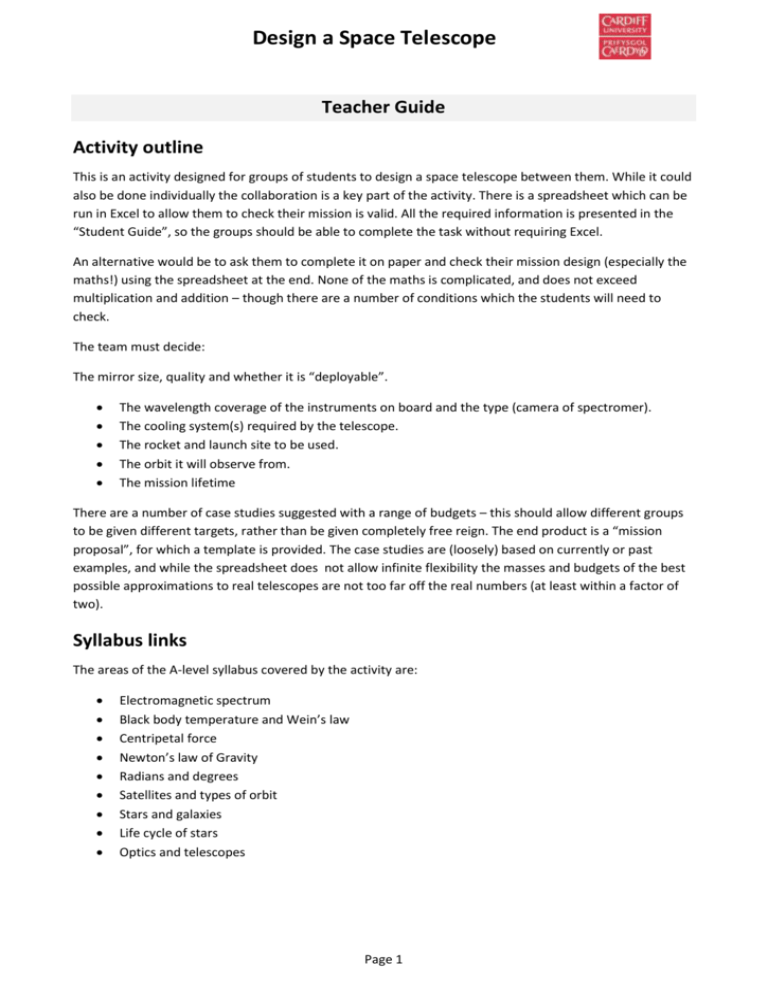
Design a Space Telescope Teacher Guide Activity outline This is an activity designed for groups of students to design a space telescope between them. While it could also be done individually the collaboration is a key part of the activity. There is a spreadsheet which can be run in Excel to allow them to check their mission is valid. All the required information is presented in the “Student Guide”, so the groups should be able to complete the task without requiring Excel. An alternative would be to ask them to complete it on paper and check their mission design (especially the maths!) using the spreadsheet at the end. None of the maths is complicated, and does not exceed multiplication and addition – though there are a number of conditions which the students will need to check. The team must decide: The mirror size, quality and whether it is “deployable”. The wavelength coverage of the instruments on board and the type (camera of spectromer). The cooling system(s) required by the telescope. The rocket and launch site to be used. The orbit it will observe from. The mission lifetime There are a number of case studies suggested with a range of budgets – this should allow different groups to be given different targets, rather than be given completely free reign. The end product is a “mission proposal”, for which a template is provided. The case studies are (loosely) based on currently or past examples, and while the spreadsheet does not allow infinite flexibility the masses and budgets of the best possible approximations to real telescopes are not too far off the real numbers (at least within a factor of two). Syllabus links The areas of the A-level syllabus covered by the activity are: Electromagnetic spectrum Black body temperature and Wein’s law Centripetal force Newton’s law of Gravity Radians and degrees Satellites and types of orbit Stars and galaxies Life cycle of stars Optics and telescopes Page 1 Design a Space Telescope Team Roles There are four roles specified, and the Student Guide is split into four sections accordingly, to allow the ability of not letting the students see the others’ guides (i.e. increase the required discussion). Rather than an entire team of four, each role could be achieved by a group. Each section of the student guide contains a few questions for the group to cover the basics, and then the details of their choices for the mission. The roles are as follows: Rocket Engineer Must choose rocket, launch site, and orbit. Questions on gravity and orbits (requires manipulation and rearrangement of equations). Other links: rocket equation, Kepler’s Laws, Angular velocity, Types of Project Manager Doesn’t make any decisions but checks the budget and schedule against the requirements/limitations, and compares with previous missions. Questions on previous missions (basic information given, but could also include online research). Instrument Scientist Selects the instruments based on the science case. Questions on Black Body temperature and Wein’s Law (requires simple equation manipulation). Other links: Effect of the atmosphere Mission Scientist Selects the mirror size and cooling system. Questions on optics and resolution (requires simple equation manipulation) Page 2 Design a Space Telescope Case Studies – Rough solutions Problems for groups (or individuals to solve) are (loosely) based on real life space observatory missions, from past, present and future. Below are rough guides as to what is necessary. While there are key requirements for each one, there are normally several variations which work and which can be left to the students’ discretion. 1) A private organization has funded your group to research into the birth and evolution of stars the distant and nearby Universe, with full analysis of the spectra of the event. The budget of your mission is £2 billion. You will need the appropriate instruments on board your satellite in order to observe such objects. Needs far-IR, sub-mm and maybe mid-IR instruments (both camera and spectrometer). Requires all three coolant types. Can get 4m mirror, 4 year mission with suitable rocket/orbit choices within budget, though could have smaller mirror and longer duration. Similar to Herschel Space Observatory. 2) A government research grant has come through to take images of the sky in ultraviolet, visible and near-IR wavelengths from a satellite in space, in order to map stars, galaxies and other yet to be discovered phenomena. The budget of your mission is £400 million. Needs UV, optical and near-IR cameras, and a UV quality mirror. To fit in budget, needs to be a 0.5m mirror, and must be launched from cheaper rocket (e.g. Pegasus), depending on mission lifetime. Similar to GALEX, but wider wavelength coverage 3) A university has approached your group to design a mission for satellite telescope in order to analyse the spectra of interstellar dust in nearby galaxies. The budget of your mission is £9 billion. You will need the appropriate instruments on board the telescope in order to carry out the mission. Requires sub-mm, far-IR and mid-IR spectrometers, and all three cooling types. The budget allows for an 8m mirror, which must be deployable to fit within the budget. Similar to Herschel Space Observatory, but bigger. 4) A private rocket company, SpaceX, has approached your group to launch a telescope into space in order to study the formation of planets and their chemical composition. The resolution must be at least four times better than previous equivalent missions, and you must use their rocket. The budget for your mission is £4 billion. Requires mid-IR camera and spectrometer, with passive cooling and one of the other types. Must be launched using Falcon 9, so max size is 4m deployable mirror. Mission can last quite a long time. Similar to Spitzer, but with larger mirror. 5) A funding agency is providing funding to perform an all-sky survey from near infrared to far infrared. The budget of your mission is £1 billion. The satellite should launch within 10 years. Requires near-R, mid-IR and far-IR cameras, and all three cooling types. Development schedule limits mirror to being 1m. Similar to IRAS. 6) Your group has received funding to send a telescope on board a satellite into space with the main objective of analysing stars in a nearby galaxy at very high resolution. You should aim to capture Page 3 Design a Space Telescope both the spectra and image data. The budget of your mission is £13 billion. Your group will need to use the appropriate instruments in order to collect data if it is to be analysed. Requires near-IR, optical and UV instruments, and an 8m mirror, which must be deployable. Requires passive cooling and one other type, but budget limits maximum duration. Similar to James Webb Space Telescope. 7) The government has asked you to design a satellite to take images of near-Earth asteroids. The mission should last for as long as possible, but the £700 million funding for the development of the satellite will expire in eight years. The European Space Agency will provide the launch and operations cost, also up to a total of £700 million, but only providing their launch site is used. Requires near-IR camera, and only passive cooling. Must be launched with Vega, Soyuz or Ariane 5 from Guiana Space Centre, into High-Earth orbit to limit launch & operation costs and still run for 20 years. Budget limits mirror to 2m mirror. Similar to WISE. Page 4 Design a Space Telescope Page 5
